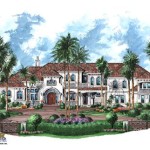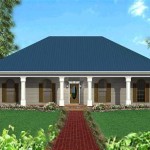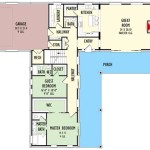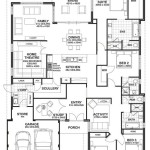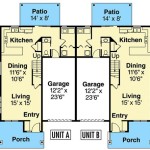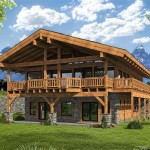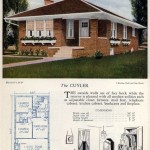Modern Single Story House Plans: Design, Functionality, and Style
Modern single-story house plans, often referred to as ranch-style or rambler homes, have experienced a resurgence in popularity. These designs prioritize accessibility, open living spaces, and a connection to the surrounding landscape. They represent a departure from multi-story dwellings, offering a simplified and often more efficient approach to residential living. This article explores the key aspects of modern single-story house plans, including their design principles, functional advantages, and aesthetic considerations.
The appeal of single-story homes stems from several factors. They are inherently more accessible for individuals with mobility challenges, including the elderly and those with young children. The absence of stairs eliminates a significant barrier, promoting independence and safety within the home. Furthermore, single-story designs can foster a stronger sense of connection between the interior and exterior environments. Wide windows, sliding glass doors, and patios seamlessly integrate indoor and outdoor living spaces, enhancing natural light and ventilation.
Modern interpretations of the single-story home prioritize open-concept layouts. This means that living rooms, dining areas, and kitchens often flow seamlessly into one another, creating a spacious and inviting atmosphere. This design approach maximizes natural light penetration and facilitates social interaction within the home.
Key Point 1: Accessibility and Universal Design
Accessibility is a core principle of modern single-story house plans. The absence of stairs makes these homes inherently more suitable for individuals with mobility impairments. However, accessibility extends beyond simply eliminating stairs. Universal design principles are often incorporated to ensure that the home is usable and comfortable for people of all ages and abilities.
Universal design features may include wider doorways and hallways to accommodate wheelchairs or walkers. Lever-style door handles are easier to operate than traditional knobs, and roll-in showers eliminate the need to step over a threshold. Kitchen and bathroom countertops can be designed with adjustable heights to accommodate users of different sizes. Non-slip flooring reduces the risk of falls, and strategically placed grab bars in bathrooms provide additional support.
The incorporation of these features enhances the usability and safety of the home for all occupants, regardless of their physical capabilities. It also future-proofs the home, making it suitable for aging in place. Investing in accessibility and universal design can significantly improve the long-term livability and value of a single-story home.
Proper planning is essential for successful implementation of accessible design elements. Architects and designers with expertise in this area can provide valuable guidance in optimizing the layout and selecting appropriate materials and finishes.
Key Point 2: Open Concept Living and Spatial Efficiency
The open-concept layout is a defining characteristic of many modern single-story house plans. By eliminating walls between living areas, designers create a sense of spaciousness and connectivity. This approach promotes natural light penetration and allows for flexible use of the space.
In an open-concept design, the kitchen often serves as the central hub of the home. A large island can provide ample counter space for food preparation and serve as a casual dining area. The kitchen island can also function as a focal point, visually separating the kitchen from the living and dining areas without completely enclosing it.
While open-concept living offers numerous benefits, it also requires careful consideration of acoustics and privacy. Sound can travel easily through open spaces, so it is important to consider using sound-absorbing materials, such as area rugs and upholstered furniture. Strategically placed screens or partitions can provide visual separation and a sense of privacy without completely closing off rooms.
Furthermore, effective storage solutions are crucial in an open-concept layout to maintain a clutter-free and organized environment. Built-in shelving, custom cabinetry, and cleverly designed storage alcoves can help to maximize space and minimize visual clutter.
Spatial efficiency is another key consideration in single-story house plans. Since the entire living space is contained on a single level, it is important to make the most of every square foot. Careful planning of room sizes and layouts can help to optimize circulation and minimize wasted space.
Key Point 3: Integration with the Outdoors and Natural Light
Modern single-story house plans often emphasize a strong connection to the outdoors. Large windows, sliding glass doors, and patios are used to seamlessly integrate indoor and outdoor living spaces. This approach allows for abundant natural light penetration and creates a sense of openness and connection with the surrounding landscape.
Sliding glass doors provide easy access to patios, decks, and gardens. These doors can be strategically placed to capture views and maximize natural light. Skylights can also be incorporated to bring additional light into darker areas of the home. Overhangs and awnings can provide shade and protection from the sun, reducing the need for artificial cooling.
Outdoor living spaces, such as patios and decks, can be designed as extensions of the indoor living areas. Outdoor kitchens, seating areas, and fireplaces can create a comfortable and inviting space for entertaining and relaxation.
Landscaping plays a crucial role in enhancing the connection between the home and its surroundings. Native plants and trees can create a natural and sustainable landscape that blends seamlessly with the local environment. Water features, such as ponds and fountains, can add a sense of tranquility and create a relaxing outdoor atmosphere.
The orientation of the home on the lot is also important for maximizing natural light and ventilation. A south-facing orientation can maximize solar gain in the winter, while strategically placed trees can provide shade and cooling in the summer. Proper ventilation can help to reduce the need for air conditioning and improve indoor air quality.
Careful consideration should also be given to the privacy of outdoor living spaces. Fences, hedges, and strategically placed trees can provide privacy from neighbors and create a more secluded and intimate outdoor environment.
In addition to these core design elements, several other considerations contribute to the overall appeal of modern single-story house plans. Material selection plays a significant role in defining the aesthetic of the home. Modern designs often incorporate natural materials, such as wood, stone, and glass, to create a warm and inviting atmosphere. Sustainable building materials, such as recycled wood and low-VOC paints, are also increasingly popular choices.
Rooflines can vary widely in modern single-story designs. Low-pitched roofs are common, but gable roofs and butterfly roofs can also be used to create visual interest. The roofline can also be designed to incorporate solar panels or a green roof, further enhancing the sustainability of the home.
Interior design elements, such as lighting fixtures, flooring, and furniture, should complement the overall aesthetic of the home. Clean lines, simple shapes, and a neutral color palette are often used to create a modern and minimalist look. However, pops of color and texture can be added to create visual interest and personalize the space. The careful selection of interior design elements can enhance the overall comfort and livability of the home.
Proper insulation and energy-efficient windows and doors are essential for reducing energy consumption and minimizing utility costs. Solar panels can provide renewable energy, further reducing the home's environmental impact. Smart home technology can also be incorporated to automate lighting, heating, and cooling systems, further enhancing energy efficiency.
The layout of a modern single-story house plan should be carefully considered to meet the specific needs of the occupants. A dedicated home office may be necessary for those who work remotely. A mudroom or entry area can provide a place to store coats, shoes, and other outdoor gear. A laundry room should be conveniently located near the bedrooms or bathrooms. The number and size of bedrooms and bathrooms should be determined based on the size of the family and their lifestyle.
Modern single-story house plans offer a versatile and appealing option for those seeking a comfortable, accessible, and stylish home. Their emphasis on open living spaces, natural light, and connection to the outdoors makes them well-suited for a variety of lifestyles. By carefully considering the design principles and functional advantages discussed in this article, prospective homeowners can create a single-story home that meets their individual needs and preferences.

Contemporary Style House Plan 3 Beds 2 Baths 1131 Sq Ft 923 166 Houseplans Com

Modern One Story House Plan Mm 2372

Our Favorite Unique One Story House Plans Blog Dreamhomesource Com

1 Story House Plans One Modern Luxury Home Floor

Hudson House Plan Sater Design Collection

Single Story Modern House Plans Designs 87651 Contemporary Design Facade Exterior

Unique And Modern Single Story 2 500 Sq Ft House Plans Blog Homeplans Com

House Plan 041 00209 Modern Farmhouse 1 850 Square Feet 4 Bedrooms 2 Bathrooms Plans Ranch

Kelso A Modern One Story House Plan With Country Kitchen 5173

House Plan 2 Bedrooms 1 Bathrooms 1909 Bh Drummond Plans

